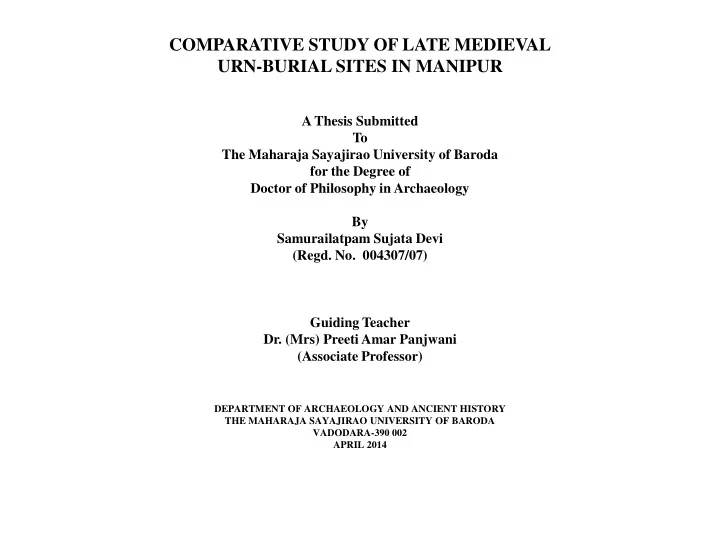

COMPARATIVE STUDY OF LATE MEDIEVAL URN-BURIAL SITES IN MANIPUR A Thesis Submitted To The Maharaja Sayajirao University of Baroda for the Degree of Doctor of Philosophy in Archaeology By Samurailatpam Sujata Devi (Regd. No. 004307/07) Guiding Teacher Dr. (Mrs) Preeti Amar Panjwani (Associate Professor) DEPARTMENT OF ARCHAEOLOGY AND ANCIENT HISTORY THE MAHARAJA SAYAJIRAO UNIVERSITY OF BARODA VADODARA-390 002 APRIL 2014
Objectives • Burial customs • Pottery morphological study • Measurement & Technology • Review & analysis of cultural resources • Ethno archaeology • Comparison & Correlation
Chapter- I Introduction • Genesis of Pottery History of Pottery in Manipur • Insight into Burial Customs Reference to Manipur
Pot Internment System
Chapter: 2 Methodology • Literary Survey • Personal Interviews • Analytical Process
Texture
Chapter: 3 Environment, Archaeological and Historical Setting • Environment • Archaeological background of Manipur Pre historic Phase Proto historic Phase Megalithic phase Historic Phase
Chapter: 4 Pottery Analysis • Pottery Shapes • Andro Khuman (24 ° 45’ 30.93” N - 94 ° 2’ 48.88” E) • Khamaran / Khamaral (24 ° 52’ 26.92” N – 93 ° 53’ 40.82” E) • Koutruk (24 ° 53’ 19.78” N - 93 ° 49’ 52.9” E) • Khangabok (24 ° 37’ 11.09” N – 94 ° 1’ 10.16” E) • Sekta (24 ° 53’ 25.58” N - 94 ° 2’ 17.42” E)
Regular, Elongated & Globular pots
Bowl (Type i, ii & iii)
Type iv, v & vi
Type vii, viii & ix
Channel Spouted Vessel (Type i, ii & iii)
Dish & Ribbed Neck Vessel
Grey Vases (Type i & ii)
Andro Khuman
Andro Khuman
10 15 20 25 30 0 5 a a(i) a(ii) a(iii) a.(iv) b b.i b.ii b.ii.a b.iii b.iv b.v Andro Khuman b.vi b.vii b.viii b.ix c ADO c.i c.ii c.iii d e e.i e.ii f g h i j k l l.i l.ii m ADO
10 0 1 2 3 4 5 6 7 8 9 a a(i) a(ii) a(iii) a.(iv) b b.i b.ii b.ii.a b.iii b.iv b.v b.vi b.vii Khamaral b.viii b.ix c KML c.i c.ii c.iii d e e.i e.ii f g h i j k l l.i l.ii m KML
10 12 14 0 2 4 6 8 a a(i) a(ii) a(iii) a.(iv) b b.i b.ii b.ii.a b.iii b.iv b.v Khamaral (MU) b.vi b.vii b.viii b.ix c KML (MU) c.i c.ii c.iii d e e.i e.ii f g h i j k l l.i l.ii m KML (MU)
10 12 14 16 0 2 4 6 8 a a(i) a(ii) a(iii) a.(iv) b b.i b.ii b.ii.a b.iii b.iv b.v b.vi b.vii Koutruk b.viii b.ix c KTK c.i c.ii c.iii d e e.i e.ii f g h i j k l l.i l.ii m KTK
10 12 0 2 4 6 8 a a(i) a(ii) a(iii) a.(iv) b b.i b.ii b.ii.a b.iii b.iv KOUTRUK (MU) b.v b.vi b.vii b.viii b.ix c KTK(MU) c.i c.ii c.iii d e e.i e.ii f g h i j k l l.i l.ii m KTK(MU)
0.2 0.4 0.6 0.8 1.2 1.4 1.6 1.8 0 1 2 a a(i) a(ii) a(iii) a.(iv) b b.i b.ii b.ii.a b.iii b.iv b.v b.vi Khangabok b.vii b.viii b.ix c KGB c.i c.ii c.iii d e e.i e.ii f g h i j k l l.i l.ii m KGB
Khangabok (State Museum) KBG(State Museum) 12 10 8 6 KBG(State Museum) 4 2 0 a a(i) a(ii) a(iii) a.(iv) b b.i b.ii b.ii.a b.iii b.iv b.v b.vi b.vii b.viii b.ix c c.i c.ii c.iii d e e.i e.ii f g h i j k l l.i l.ii m
10 0 1 2 3 4 5 6 7 8 9 a a(i) a(ii) a(iii) a.(iv) b b.i b.ii b.ii.a b.iii b.iv b.v b.vi b.vii b.viii Sekta b.ix c SKT c.i c.ii c.iii d e e.i e.ii f g h i j k l l.i l.ii m SKT
Chapter: 5 Ethno-archeology • Ningthemcha Karong • Thongjao
Ningthemcha Karong
Nganthak Khangabok Sanggai Yumpham, Kangla
Implements
Pulverizing ( leibak sugaiba ) Clay lump Boulde r as platform
Kneading ( totpa ) Pounded clay wooden pounder (toksu)
Preliminary shaping ( leimi tamba ) Rough shaping Palm full of lump Preliminary rough models
Piercing (hutpa)
Pundrei
Phundrei
Final Shaping ( Khetpa )
Decoration
Drying in the Sun ( phauba )
First Stage of Firing ( mei ietpa )
Second Stage of Firing
Final Firing
Ethnographic Model
Thongjao
Implements
Raw Material
Winnowing & Pulverizing
Kneading
Forming a coil & slab
Shaping
Shaping of rim
Rough model & Drying
Final Shaping
Decorating
Firing
Storage & Market
Chapter: 6 Comparison, Correlation and Conclusion • Comparison and Correlation • Burial style (human relic) • Shape of the innermost vessel • Number and selection of pottery • Number of pottery internment • Style of lid • Number of mortuary goods and its style • Metal and stone mortuary goods
Chapter 6 • Conclusion • Problems or limitations
THANK YOU
Recommend
More recommend